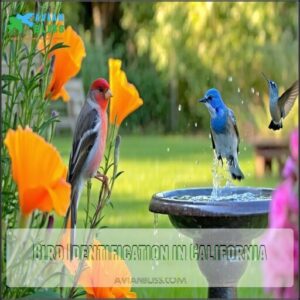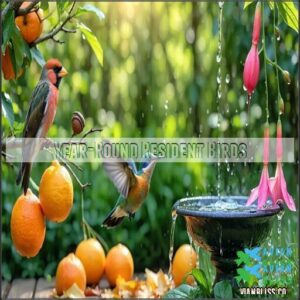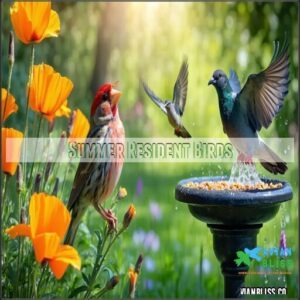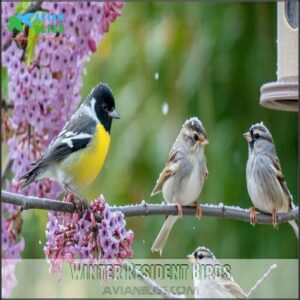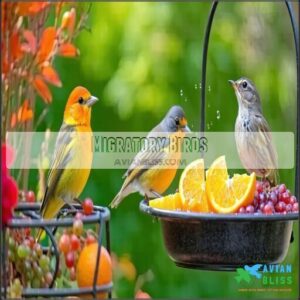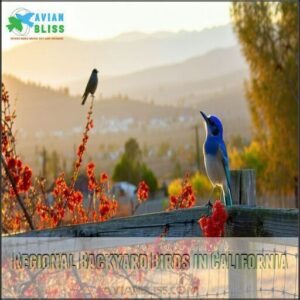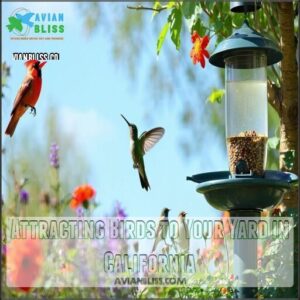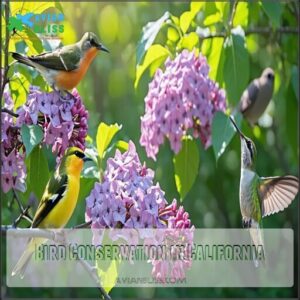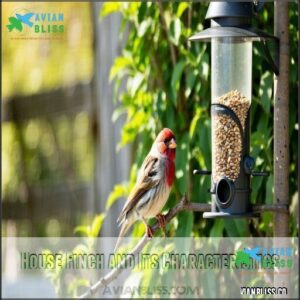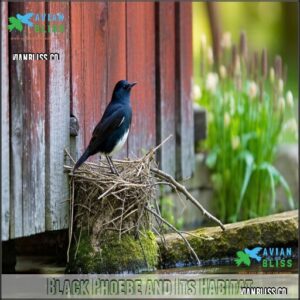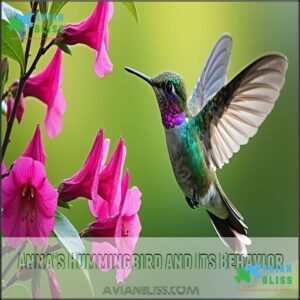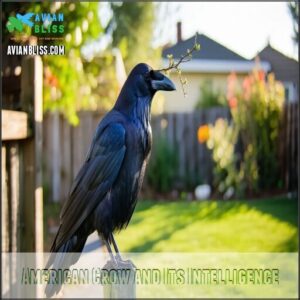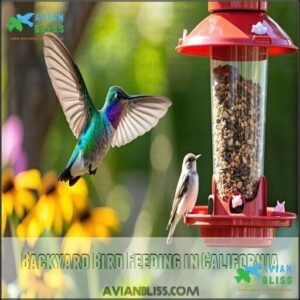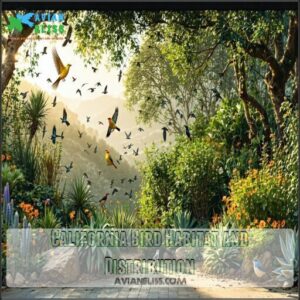This site is supported by our readers. We may earn a commission, at no cost to you, if you purchase through links.
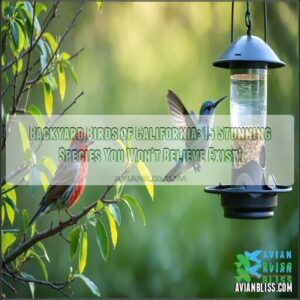
Common visitors include the bright red House Finch, iridescent Anna’s Hummingbird, and the vocal California Scrub-Jay.
Along coastal areas, you might spot Black Phoebes catching insects, while inland gardens often host American Goldfinches and Oak Titmice.
Northern California attracts different backyard birds of California than southern regions due to varied ecosystems.
Most species respond well to appropriate feeders and native plantings like manzanita and ceanothus.
The right combination of food, water, and shelter transforms your yard into a bird sanctuary where even rare species might make surprise appearances.
Table Of Contents
- Key Takeaways
- Bird Identification in California
- Common Backyard Birds in California
- Regional Backyard Birds in California
- Attracting Birds to Your Yard in California
- California Bird Behavior and Migration
- Bird Conservation in California
- California Bird Species
- Bird-Watching in California
- Backyard Bird Feeding in California
- California Bird Habitat and Distribution
- Frequently Asked Questions (FAQs)
- What are the most common backyard birds in California?
- What are some common backyard birds in Los Angeles?
- Are birds endangered in California?
- Are there mockingbirds in California?
- What is the most common bird in California?
- How can I identify a bird in my yard?
- What are the tiny GREY birds in California?
- What does a California finch look like?
- Can You bird in your backyard?
- How do I identify a bird in my backyard?
- Conclusion
Key Takeaways
- You’ll find diverse bird species in California backyards year-round, including House Finches, Black Phoebes, Anna’s Hummingbirds, and California Scrub-Jays, with different species appearing based on your specific region.
- You can attract more birds by providing appropriate feeders, clean water sources, and native plants like manzanita and ceanothus that create natural food sources and shelter.
- You’ll notice distinct bird behaviors throughout the year, from territorial displays and mating rituals in spring to migration patterns along the Pacific Flyway in fall and winter.
- You’re playing a vital role in bird conservation when you create bird-friendly spaces, as many California bird populations face threats from habitat loss, climate change, and urban development.
Bird Identification in California
You’ll recognize California’s diverse backyard birds by focusing on distinctive features like the House Finch’s red head, Black Phoebe’s white belly, or Anna’s Hummingbird’s rose-pink throat.
With consistent observation and the right resources, you can identify common species such as the California Scrub-Jay, American Crow, and Mourning Dove that frequent your yard throughout the seasons.
Key Factors for Bird Identification
With the right clues in hand, identifying California’s backyard birds becomes an exciting puzzle instead of a frustrating mystery.
When spotting birds in your yard, focus on these essential identification factors:
- Bird Size – Compare to familiar objects: Anna’s Hummingbird (golf ball), House Finch (tennis ball), American Crow (football)
- Plumage Coloration – Note distinctive markings like the California Scrub-Jay’s electric blue or Black Phoebe’s contrasting black-and-white pattern
- Habitat Clues – Watch where they appear—bushes, treetops, ground, or water edges often reveal species preferences
- Vocalizations – Listen for unique songs and calls that serve as audio fingerprints
Bird Behavior provides additional confirmation—the Black Phoebe’s tail-flicking or the California Quail’s hurried ground-running are unmistakable once you’ve learned to spot them.
Many people attract birds using various bird feeders to observe them closely.
Using Bird Identification Apps
When you spot an unfamiliar visitor at your feeder, bird identification apps transform your smartphone into a pocket ornithologist.
Apps like Merlin Bird ID offer remarkable photo recognition and sound-matching features specifically calibrated for California birds.
For beginners, the Cornell Lab’s app provides simple interfaces with step-by-step identification prompts, while advanced users appreciate eBird’s detailed tracking capabilities and rare species alerts.
Most apps store California backyard birds data offline—perfect for mountain or coastal birdwatching where reception fails.
Before downloading, consider each app’s feature comparison and data privacy policies.
For best app accuracy, capture birds in good lighting and from multiple angles.
These digital guides make identifying everything from common House Finches to elusive California Quail surprisingly straightforward.
Common Mistakes in Bird Identification
Why do so many California bird enthusiasts misidentify backyard visitors? Even experienced watchers make these common identification mistakes when observing similar species.
When identifying California birds, avoid these pitfalls:
- Overlooking plumage variation: Juvenile birds often look drastically different from adults, while seasonal changes can transform familiar species completely.
- Ignoring size context: Without reference points, a distant Western Bluebird might be confused with a closer Mountain Bluebird.
- Relying solely on visual cues: Many common birds have distinctive songs and calls that provide better identification than appearance alone.
Remember that California bird identification improves with practice. Take photos when possible, listen for auditory cues, and consult multiple sources before confirming your backyard birds’ identity.
Importance of Habitat in Bird Identification
Habitat clues act as a bird detective’s magnifying glass when identifying California’s feathered residents.
Your backyard’s specific environment—whether woodland edge, chaparral, or urban oasis—directly determines which species you’ll encounter. Notice where birds perch, feed, and nest; these behaviors reflect their ecological niche.
Regional variations throughout California create distinct bird communities, with coastal areas attracting different species than inland valleys.
Food sources like berry bushes or nectar plants attract specific birds, while nesting locations provide additional identification hints.
California birdwatching becomes more rewarding when you connect native plants to the bird species they support, and understand how these elements contribute to the overall bird communities in your area, making it easier to identify California’s feathered residents.
Common Backyard Birds in California
You’ll spot colorful House Finches, elegant Black Phoebes, and iridescent Anna’s Hummingbirds right in your California backyard, with species varying by season and region.
From the iconic California Quail to the intelligent American Crow, these feathered visitors create a vibrant ecosystem that you can observe and support with appropriate feeders and native plants, which is a key factor in maintaining a healthy ecosystem.
Year-Round Resident Birds
While identifying birds requires keen observation, understanding which feathered friends stay year-round helps you create lasting relationships with your backyard visitors.
California’s year-round resident birds showcase remarkable adaptation strategies to weather all seasons in your backyard. These faithful companions become familiar faces through changing seasons.
- House Finches brighten winter days with their rosy hues and cheerful melodies, demonstrating urban survival at its finest.
- Black Phoebes perform aerial acrobatics, snatching insects mid-flight like tiny avian ninjas.
- California Scrub-Jays, with their brilliant blue plumage, cache thousands of acorns annually, supporting habitat changes through accidental tree planting.
- Anna’s Hummingbirds defend territories with impressive dive displays despite their tiny size.
- California Towhees quietly forage beneath shrubs, their subtle brown plumage hiding complex breeding habits.
These California bird species maintain stable conservation status thanks to their adaptability. Understanding their feeding habits and needs is key to supporting their survival. By understanding their needs, you’ll witness fascinating behaviors right outside your window every month of the year, and develop a deeper appreciation for these faithful companions and their adaptation strategies.
Summer Resident Birds
When summer arrives in California, a colorful cast of winged visitors transforms your backyard into a bustling avian hotspot.
During Nesting Season, your garden becomes prime real estate for California bird species like the Mourning Dove, appearing in 42% of summer checklists. House Finches deliver cheerful melodies while Black Phoebes dart from perches to catch flying insects during peak Insect Abundance.
To enhance your California birdwatching experience, maintain Water Availability through birdbaths and create feeding stations with black oil sunflower seeds. You’ll witness fascinating Territory Defense displays as males establish boundaries through distinctive calls and flights.
Early mornings offer the best viewing opportunities when backyard birds are most active. Watch for Molting Patterns as summer residents refresh their plumage.
Native flowering plants support these seasonal visitors far better than commercial feeds alone, providing natural nourishment that helps them thrive throughout the warm months in your California sanctuary.
Winter Resident Birds
California’s winter landscape transforms as seasonal birds arrive, bringing new colors and sounds to your backyard bird sanctuary.
When temperatures drop, these winter residents become regular visitors:
- Yellow-rumped Warblers flash their bright yellow patches while hopping through shrubs
- White-crowned Sparrows gather in small flocks, scratching for seeds beneath feeders
- Dark-eyed Juncos (nature’s "snowbirds") forage on the ground with their distinctive tail-flicking
- Ruby-crowned Kinglets zip through branches with nervous energy, occasionally revealing their hidden red crown
- Golden-crowned Sparrows announce their presence with melancholy three-note whistles
These winter bird IDs become easier with practice. Many species form mixed feeding flocks for protection, sharing roosting behavior in dense vegetation. Their cold adaptations include specialized feather insulation and communal huddling. You’ll notice different habitat preferences and feeding strategies as they navigate California’s mild winter climate.
Migratory Birds
Your California backyard transforms into a vital hub along the Pacific Flyway when numerous migratory birds pass through each year.
These feathered travelers respond to migration triggers like changing daylight and temperature, making your yard an essential stopover ecology site.
| Species | Best Time to Spot | Conservation Status | Diet | Attracts With |
|---|---|---|---|---|
| Western Tanager | April-May | Stable | Insects, Fruit | Orange slices |
| Bullock’s Oriole | Spring | Declining | Nectar, Insects | Grape jelly |
| Wilson’s Warbler | Fall | Vulnerable | Insects | Native plants |
| Ruby-crowned Kinglet | September-October | Stable | Insects | Suet |
| Swainson’s Thrush | May | Climate-impacted | Berries, Insects | Water features |
Support these remarkable travelers by participating in citizen science projects tracking bird migration patterns affected by climate impacts.
Regional Backyard Birds in California
You’ll find distinct bird populations across California’s diverse regions, from the scrub jays of San Francisco to the mockingbirds of Los Angeles.
The specific species you’ll spot in your backyard depend on your location within the state, whether you’re near the foggy coast, sun-drenched valleys, or pine-covered mountains.
Common Backyard Birds in Los Angeles
You’ll discover a remarkable array of urban bird species right in your Los Angeles backyard.
The House Finch, with males sporting vibrant red plumage and females showing subtle brown streaks, visits feeders stocked with sunflower seeds and peanuts.
California Scrub-Jays add electric-blue splashes to your garden, performing distinctive hops and lunges during mating season while fanning their tailfeathers.
Look for these backyard birds in LA:
- American Crows gathering in family groups of 3-10, their distinctive "caw" announcing their presence
- Tiny Bushtits moving in social flocks, constructing remarkable hanging pouch nests
- Allen’s Hummingbirds flashing orange-red throat patches as they visit your nectar feeders
Even during drought, these local birds adapt to native habitats and continue filling neighborhoods with their distinctive bird sounds year-round.
Common Backyard Birds in San Francisco
San Francisco’s foggy climate creates a unique haven for backyard birds unlike those found in LA.
Your urban bird habitat can attract an impressive variety of feathered visitors:
- House Finches and California Scrub-Jays frequent feeders with sunflower seeds and peanuts
- White-crowned Sparrows and Dark-eyed Juncos hop along ground feeding areas
- Chestnut-backed Chickadees and Bushtits flit through native shrubs hunting insects
Set up a simple birdbath near protective cover and you’ll transform your SF backyard into a birdwatching hotspot, supporting local conservation efforts through habitat creation.
Common Backyard Birds in Sacramento
Moving from San Francisco’s foggy coastline, Sacramento offers its own unique backyard bird population.
You’ll frequently spot the Bushtit and California Scrub-Jay visiting feeders in urban settings.
| Bird Species | Feeding Strategy | Urban Adaptation |
|---|---|---|
| House Finch | Seed lover | Thrives near homes |
| Cedar Waxwing | Berry specialist | Seasonal visitor |
| Black-headed Grosbeak | Mixed diet | Melodious singer |
The Yellow-billed Magpie, found nowhere else in the world except California’s Central Valley, often visits Sacramento backyards.
American Crows demonstrate remarkable intelligence as they navigate Sacramento habitats, while the Mourning Dove’s gentle cooing provides a peaceful soundtrack to your backyard bird watching experience. The California Scrub-Jay and other species contribute to the diverse bird population in the area, making it an ideal location for bird enthusiasts.
Backyard Birds in California’s Coastal Regions
The coastline brings an invigorating mix of backyard birds, offering unique birdwatching in California‘s coastal areas.
These urban coastal birds thrive in diverse habitats, blending shoreline charm with backyard appeal.
- Black Phoebes perch low, catching insects with precision.
- Anna’s Hummingbirds flit among nectar-rich coastal gardens.
- California Towhees forage through leaf litter for seeds.
- Western Gulls glide overhead, linking yards to oceanfront life.
Coastal migration patterns make your yard a pit stop for nesting coastal birds.
Protecting coastal birds guarantees these species continue to enchant California birdwatching locations.
Backyard Birds in California’s Mountain Regions
California’s mountain regions offer a birdwatcher’s paradise distinct from coastal areas.
The Steller’s Jay’s vibrant blue plumage stands out among pine forests, while Dark-Eyed Juncos flash their white tail feathers while foraging.
Mountain Chickadees, identified by their white eyebrow stripe, readily visit tube feeders stocked with black oil sunflower seeds and suet.
You’ll spot White-Crowned Sparrows with their distinctive black-and-white striped heads, especially active under feeders.
The nomadic Pine Siskin might appear at your mountain feeder one year and vanish the next.
For successful mountain birdwatching, provide appropriate food sources and consider the seasonal patterns of these high-altitude birds.
Attracting Birds to Your Yard in California
You can attract a variety of birds to your California yard by providing food, water, and shelter suited to their needs.
Native plants, well-placed feeders, and clean water sources create an inviting habitat for local species.
Choosing The Right Bird Feeders
To make your yard a hotspot for backyard birds, picking the right bird feeders is key.
Different feeder types attract specific species.
Tube feeders are perfect for finches and chickadees, while platform feeders bring in jays and towhees.
Hopper feeders cater to seed-lovers like House Finches, and nectar feeders are a hit with Anna’s Hummingbirds.
Consider various tube feeder options for attracting more birds.
Placement strategies matter too—set feeders near shrubs for safety but keep flight paths open.
Squirrel-proofing saves your bird seed and your patience, so consider models with built-in guards.
Don’t forget cleaning feeders regularly; a monthly rinse with a mild bleach solution keeps diseases at bay.
Finally, match bird seed to species’ preferences for better bird attraction.
Your backyard bird buffet awaits!
Providing a Water Source for Birds
Clean water is a magnet for backyard birds in California, especially during dry spells. A well-placed water source keeps birds hydrated and happy while adding life to your yard.
Bird baths should be shallow (1-2 inches) with textured surfaces to prevent slipping. Gentle movement, like bubbling fountains, draws in more birds than stagnant water.
Consider various bird bath designs to attract different species. Place baths in partial shade to keep water cooler and slow algae growth. Clean weekly with a brush to avoid spreading disease.
- **Watch sparrows splash joyfully in shallow baths.
- **Hear hummingbirds sip from bubbling fountains.
- **Help thirsty birds survive scorching summers.
- **Create a safe haven for year-round visitors.
Planting Native Vegetation for Birds
Native plants are the backbone of bird-friendly gardens, offering food, shelter, and nesting spots for backyard birds.
Select plants like toyon, elderberry, and manzanita for berries, or salvias and penstemons for seasonal blooms that attract hummingbirds.
Layer your garden with ground covers, shrubs, and flowering plants to mimic natural habitats. Native plant selection also supports habitat restoration and water conservation, essential for California’s ecosystems.
To find the right species, consider bird-friendly native options.
Here’s a handy guide:
| Plant Type | Example Plants | Benefits for Birds |
|---|---|---|
| Ground Covers | Yarrow, Sagebrush | Shelter, insects for food |
| Shrubs | Toyon, Manzanita | Berries, nesting spots |
| Flowering Plants | Penstemon, Salvia | Nectar for hummingbirds |
| Trees | Oak, Elderberry | Seeds, berries, perches |
| Grasses | Deer Grass | Seeds, cover for ground birds |
Offering Birdhouses and Nesting Sites
After adding native plants, it’s time to give your backyard birds safe, cozy spaces to nest.
Birdhouses are a fantastic way to support cavity nesters like Western Bluebirds and Oak Titmice. Placement is everything—mount them 5-12 feet high, away from wind and harsh afternoon sun.
Here are some bird attraction strategies to keep in mind:
- Choose durable materials like cedar or redwood for insulation and decay resistance.
- Use proper birdhouse sizes with the right entrance holes (e.g., 1½" for bluebirds).
- Install predator guards to keep eggs and chicks safe from unwanted visitors.
- Provide natural nesting materials nearby, like twigs or dry grass.
Don’t forget to clean birdhouses every winter. This prevents parasites and guarantees your feathered friends can return to a healthy, welcoming home year after year.
California Bird Behavior and Migration
You’ll notice California’s backyard birds follow fascinating seasonal migration patterns, with some species traveling thousands of miles while others stay put year-round.
Their behaviors, from intricate songs to social flocking, reveal how they adapt to changing environments and guarantee survival.
Understanding Bird Migration Patterns
As you attract birds to your yard, you’ll notice some come and go with the seasons—a fascinating glimpse into bird migration patterns.
In California, these migrations are guided by migration triggers like daylight changes and food availability. Birds rely on navigation methods such as the sun, stars, and Earth’s magnetic field to travel.
Here’s a quick look at migration:
| Aspect | Details | Examples |
|---|---|---|
| Migration Triggers | Daylight, temperature shifts | Yellow-rumped Warbler migration |
| Navigation Methods | Magnetic fields, star maps | Anna’s Hummingbird adjustments |
| Stopover Ecology | Rest sites for refueling | Wetlands, urban gardens |
These journeys reflect California bird behavior, habitats, and diets, but they’re increasingly shaped by climate change and conservation impacts.
Bird Migration Routes and Timing
California sits along the Pacific Flyway, a critical route for migratory birds.
Over 350 bird species in California rely on this aerial highway, shaped by Flyway Ecology and Climate Impacts. Timing aligns with Migration Triggers like food availability and weather changes.
Here’s what to watch for:
- Winter visitors: Yellow-rumped Warblers and White-crowned Sparrows arrive as temperatures drop.
- Spring arrivals: Lesser Goldfinches and flycatchers return with longer days.
- Fall stopovers: Many species pause in California’s Stopover Habitats during their southbound journey.
Citizen Science projects help track these bird migration patterns, enriching your birdwatching in California.
Bird Behavior and Social Structure
Bird behavior in your California backyard is like a live nature documentary.
House Finches exhibit flock dynamics, sticking together in small groups for safety. American Crows, known for their social learning, even teach their young survival tricks.
California Scrub-Jays fiercely defend their territory, often chasing off intruders. Watch for White-crowned Sparrows establishing pecking orders at feeders or Anna’s Hummingbirds dazzling with intricate mating rituals.
Each species adds its own flair to this lively backyard bird society. Dominance in bird hierarchies is often influenced by plumage and strength, which can be a key factor in flock dynamics and overall bird behavior.
Bird Communication and Songs
Your backyard is alive with bird sounds, each carrying its own message. These aren’t just random chirps—they’re intricate communication tools shaped by bird behavior.
Bird songs and calls vary in purpose and style. The California Scrub-Jay, for example, uses sharp alarm calls to warn others of lurking predators. Mockingbirds showcase vocal mimicry, imitating other species or even urban noises to establish dominance or attract mates.
Here’s how birds communicate daily:
- Alarm calls: Sharp signals to warn of threats like cats or hawks.
- Song complexity: Elaborate tunes to claim territory or woo a mate.
- Silent communication: Subtle movements like tail flicks to coordinate within flocks.
Each sound enriches your garden, creating a symphony of connection and survival.
Bird Mating and Breeding
Springtime transforms your yard into a lively stage for backyard birds’ mating rituals.
From March to August, bird breeding seasons bring fascinating behaviors like nest building and chick rearing.
You’ll spot bird nests tucked in quiet corners as species prepare for egg incubation and fledgling survival.
| Species | Mating Rituals | Breeding Season |
|---|---|---|
| Anna’s Hummingbird | Daring dive displays | December-May |
| California Scrub-Jay | Hopping and lunging | March-June |
| Black Phoebe | Tail-wagging courtship | March-July |
Keep an eye out for these moments—they’re nature’s finest performances!
Bird Conservation in California
You can play a significant role in protecting California’s birds by understanding the challenges they face, like habitat loss and climate change.
Simple actions, such as planting native plants or reducing pesticide use, make a big difference in supporting bird populations, which is a key factor in maintaining bird populations.
Threats to California Bird Populations
Bird populations in California face challenges that threaten their survival, often linked to human activities and environmental changes.
Habitat loss, driven by urbanization and agriculture, destroys the nesting and feeding areas birds like the California Scrub-Jay rely on. Climate change adds to the strain, altering migration patterns and food availability, while extreme weather events disrupt breeding cycles.
Invasive species outcompete native birds for limited resources, further stressing ecosystems. Window collisions and outdoor cats also account for millions of bird deaths annually. Pesticide use harms birds directly or by depleting their insect food sources, leaving species like the Chestnut-backed Chickadee vulnerable.
Here’s how these threats stack up:
- Habitat loss eliminates essential bird habitats.
- Climate change disrupts migration and breeding.
- Invasive species outcompete native birds.
Protecting bird habitats through conservation efforts is essential for their survival.
Conservation Efforts in California
In the context of bird conservation efforts, California’s approach is a mix of science and community action.
These initiatives aim to counter threats like habitat loss, invasive species, and climate change.
Key strategies include:
- Habitat Restoration: Rebuilding wetlands and forests critical to migratory and native birds.
- Policy Changes: Limiting pesticide use and promoting eco-friendly practices near nesting sites.
- Public Awareness: Educating communities about backyard birds and conservation.
- Wildlife Sanctuaries: Protecting breeding grounds and safe havens across the state.
The California Audubon Society leads these efforts, ensuring bird populations thrive through research and advocacy, making bird conservation a shared responsibility for all.
Creating a Bird-Friendly Yard in California
To turn your yard into a haven for backyard birds, focus on three essentials: food, water, and shelter. A well-designed bird-friendly garden mimics nature, attracting species like the California Scrub-Jay.
Here’s how you can create one:
| Feature | Purpose | California Options |
|---|---|---|
| Water Features | Drinking & bathing | Birdbaths with shallow water, add pebbles |
| Native Plants | Food & cover | Toyon, Manzanita, Ceanothus |
| Nesting Boxes | Safe breeding spots | Adjust size for species |
| Organic Gardening | Insect-rich habitat | Avoid pesticides |
Plant in layers—trees, shrubs, and ground cover—to suit different bird needs. Add feeders with black oil sunflower seeds for a quick snack. Native plants also feed birds and support insects they rely on.
A simple water feature completes your sanctuary, ensuring your bird-friendly garden thrives year-round.
Managing Pests and Predators in California Yards
Protecting your backyard birds in California means staying ahead of pests and predators.
Common threats like squirrels, cats, and even larger birds can disrupt your bird-friendly haven.
Here’s how to safeguard your feathered visitors:
- Install squirrel-proof feeders with baffles and place them far from fences or trees.
- Use humane solutions like motion-activated sprinklers to keep cats away without harm.
- Modify the habitat with pest-resistant native plants that offer cover while deterring intruders.
These predator deterrents also protect your bird feeders and birdhouses, and support bird conservation by creating a balanced, safe environment for your backyard birds.
Maintaining a Bird-Friendly Yard in California
Creating a bird-friendly yard in California is easier than you think.
Start with native plants like California sagebrush or toyon—they’re a buffet for backyard birds. Add water features like shallow bird baths, keeping them clean and fresh.
Use nesting boxes and bird houses to encourage breeding, and place bird feeders filled with seeds or suet. Avoid chemicals; they harm birds and their food sources.
Design your yard with layers—shrubs, trees, and open spaces—for shelter and foraging. Finally, practice predator control by keeping cats indoors.
These steps will turn your yard into a thriving, bird-friendly garden.
California Bird Species
California is home to an incredible variety of bird species, each adapted to its unique environment.
From the vibrant Anna’s Hummingbird to the intelligent American Crow, these birds bring life and diversity to backyards across the state.
House Finch and Its Characteristics
The cheerful House Finch is a backyard favorite in California, easily recognized by its male coloration—vivid red heads and breasts—and the brown-streaked females.
These adaptable birds thrive in urban and rural settings, making them a perfect addition to your bird identification worksheets. Their diet preferences lean heavily on seeds, especially black oil sunflower seeds, which you can offer in tube feeders to attract them.
Here’s what makes House Finches fascinating:
- Males’ red hues depend on their bird diet, with brighter colors signaling better nutrition.
- They build cup-shaped nests in shrubs, trees, or even hanging plants.
- You’ll often spot them feeding in flocks, showcasing their finch socialization.
- Their melodic songs are a delight during the day.
- These backyard birds are year-round residents, ensuring constant company.
Black Phoebe and Its Habitat
The Black Phoebe, with its sleek black body and crisp white belly, is a favorite among backyard birds in California.
Known for its Nesting Habits, it builds sturdy mud nests under eaves, bridges, or sheltered spots, often near water.
This bird thrives in urban and rural bird habitats, relying on Water Proximity to hunt flying insects.
Its Phoebe Diet includes a variety of insects, making it a natural pest controller.
You’ll spot it perched low, wagging its tail, then darting out with precision.
Adding native plants to your yard can boost Insect Attraction, keeping this charming bird nearby year-round.
Anna’s Hummingbird and Its Behavior
Anna’s Hummingbirds, dazzling backyard birds in California, showcase incredible bird behavior. Their courtship displays are breathtaking—males soar 130 feet, then dive at 60 mph, their wings producing chirping sounds.
These tiny warriors fiercely guard feeding territories, flashing iridescent magenta throats during territoriality battles.
- Females craft walnut-sized nests using spider silk and lichen.
- Their winter adaptations allow year-round nectar consumption and insect feeding.
- Hovering, flying backward, and mid-air spins highlight their agility.
- Vocalizations add charm to their vibrant presence in California bird habitats.
American Crow and Its Intelligence
The American Crow is a standout among California’s common birds, known for its incredible bird intelligence.
You’ll spot this clever creature mastering Crow Tool-Use, like using sticks to grab food.
Their Crow Problem-Solving skills include recognizing human faces and even teaching tricks through Crow Socialization.
With sharp Crow Memory, they remember threats for years.
Observing their advanced Crow Communication and bird behavior in California reveals why they’re a favorite for bird enthusiasts.
Mourning Dove and Its Mating Habits
Mourning Doves, one of California’s most common birds, captivate with their tender courtship rituals and devoted parenting.
During mating season, males perform graceful figure-eight flights, their wings producing a unique whistling sound to attract a mate. These doves form lifelong bonds, showcasing remarkable teamwork in raising their young.
You’ll notice:
- Males puffing their chests while cooing softly at dawn
- Pairs gently touching beaks, resembling a kiss
- Both parents alternating nest-building, incubation, and feeding duties
Mourning Doves are exceptional among bird species for producing "dove milk," a nutrient-rich secretion from their crop that guarantees fledgling success. Their attentive parental care and synchronized nesting efforts make them a fascinating addition to any backyard, embodying the beauty of bird nesting and family life.
Bird-Watching in California
California offers some of the best bird-watching opportunities with its diverse habitats, from coastal wetlands to mountain forests.
You’ll find countless species to observe, whether you’re exploring trails or enjoying your own backyard, with diverse habitats that make it an ideal location.
California Birding Locations
Based on my web search for "top California birding locations coastal mountain desert urban wetland hotspots", here are the key findings:
- Top California birding locations include diverse habitats from coastal areas to mountains, deserts, urban settings, and wetlands.
- Notable hotspots include:
- Coastal: Point Reyes National Seashore, Bolsa Chica Ecological Reserve
- Mountain: Yosemite National Park, Mount Palomar
- Desert: Anza-Borrego Desert State Park, Salton Sea
- Urban: Golden Gate Park (San Francisco), Griffith Park (Los Angeles)
- Wetland: Sacramento National Wildlife Refuge, Elkhorn Slough
- The state features several important bird areas along the Pacific Flyway migration route.
- California has over 650 recorded bird species, making it one of the most bird-diverse states.
- Popular birding trails include the Central Valley Birding Trail and the San Diego Bird Trail.
- Many locations offer guided birding tours and educational programs for beginners and experienced birders alike.
Where will you find California’s incredible bird diversity? From coastal wetlands to mountain forests, California offers premier birdwatching locations for every enthusiast.
Check out these California birdwatching hotspots:
- Bolsa Chica Wetlands – Witness hundreds of wetland birds in their natural coastal habitat.
- Anza-Borrego Desert State Park – Spot unique desert species against stunning arid landscapes.
- Yosemite National Park – Discover mountain birds among ancient sequoias and alpine meadows.
Urban birding thrives at Martin Luther King Jr. Regional Shoreline Park, while Moss Landing offers unmatched coastal birding between Santa Cruz and Monterey.
Bird-Watching Tips and Techniques
Now that you’ve explored California’s prime birding locations, let’s perfect your bird watching skills with proven techniques.
Choose binoculars that fit your hands comfortably and match your budget. You’ll spot more details on California’s diverse species with proper magnification. Field guides help identify markings, while learning sound identification lets you recognize birds by their calls even when they’re hidden.
| Technique | Difficulty | Best For |
|---|---|---|
| Still watching | Easy | Beginners |
| Sound ID | Medium | Hidden birds |
| Photography | Medium | Documentation |
| Journaling | Easy | Learning |
| Ethical birding | All levels | Conservation |
Reorganizing your approach to bird watching with these methods will enhance your experience, allowing you to spot more details and enjoy the hobby more fully, while also considering the importance of conservation and proper magnification.
California Birding Trails and Routes
Now that you’ve mastered bird-watching techniques, it’s time to hit California’s incredible birding trails. From coastal birding at Point Reyes National Seashore to desert trails at Big Morongo Canyon Preserve, the state offers diverse bird watching locations.
Mountain routes along the Eastern Sierra showcase spectacular species in varying elevations, while urban birding paths through state parks provide accessible trails close to home.
- For wheelchair-accessible wildlife refuges, try the boardwalks at Arcata Marsh or Elkhorn Slough National Estuarine Reserve.
Birding Festivals and Events in California
After exploring California’s beautiful birding trails, you’ll want to mark your calendar for these unforgettable festivals.
California’s birdwatching events offer opportunities to enhance your skills while connecting with fellow enthusiasts.
| Festival | When | Featured Species |
|---|---|---|
| Morro Bay Bird Festival | January | Waterfowl, Shorebirds |
| San Diego Bird Festival | Feb-March | Seabirds, Migrants |
| Mono Basin Bird Chautauqua | June | Mountain Species |
| SF Bay Flyway Festival | February | Ducks, Hawks |
| California Duck Days | April | Waterfowl |
These community-focused events combine conservation workshops, guided tours, and expert lectures. You’ll spot species you’d never see in your backyard while learning techniques to improve your birdwatching skills.
Many festivals also highlight peak migration seasons for ideal viewing.
Backyard Bird Feeding in California
You’ll transform your California backyard into a bustling avian hotspot with the right combination of feeders and food types specific to local species.
From black oil sunflower seeds that attract House Finches to nectar feeders that draw Anna’s Hummingbirds year-round, choosing regionally appropriate offerings guarantees you’ll enjoy constant visits from the Golden State’s diverse bird population, including visits from Anna’s Hummingbirds.
Types of Bird Food for California Birds
Bird enthusiasts know that menu selection makes all the difference in attracting California’s diverse avian visitors.
The right bird foods transform your yard into a bustling wildlife restaurant suited to local species’ seed preferences.
- Black-oil sunflower seeds reign supreme, providing high-fat nutrition that House Finches and California Scrub-Jays can’t resist
- Nyjer seeds attract finches like magnets, especially when offered in specialized tube feeders
- Suet varieties appeal to insect-eaters like Black Phoebes, particularly during cooler months
- Fruit offerings entice mockingbirds and thrushes, while nectar types keep Anna’s Hummingbirds buzzing around
Position bird feeders near protective cover where birds can retreat quickly from predators.
For best results, combine multiple food types to satisfy the diverse California bird diet. Clean feeders regularly to prevent disease spread among your feathered guests.
Tips for Feeding Birds in California
Now that you know what to feed California’s backyard birds, let’s talk about how to serve it up properly.
You’ll have greater success attracting diverse species when you match feeder types to specific seed types. Tube feeders work wonders for sunflower seeds, while platform feeders accommodate larger California quails.
Position feeders near native plants but away from predator hiding spots. Don’t forget water sources—birds need drinking and bathing options year-round in California’s climate.
Clean feeders weekly to prevent disease, especially during rainy seasons. Consistency is key—your feathered friends will rely on your bird-friendly garden once they discover it.
Common Mistakes in Backyard Bird Feeding
Now that you know what to feed your backyard birds, let’s look at what not to do. Even well-intentioned bird enthusiasts make mistakes that can discourage or harm their feathered visitors.
Seed contamination and poor feeder hygiene are top concerns for California bird lovers. You’ll want to clean feeders weekly to prevent harmful mold growth that causes deadly avian diseases.
- Wrong food choices can deprive birds of necessary nutrition – cheap mixes often contain fillers that California species won’t eat
- Predator exposure happens when feeders are placed without considering neighborhood cats or hawks
- Overfeeding issues lead to unhealthy bird populations and attract pests
- Neglecting feeder maintenance creates dangerous bacterial breeding grounds
- Inconsistent feeding schedules confuse birds who rely on your backyard restaurant
Remember, proper bird feeding practices create healthy habitats that benefit California’s diverse avian community.
California Bird Habitat and Distribution
Now that you’ve learned about feeding California’s birds, let’s look at where they actually live.
California’s diverse landscape creates a mosaic of habitats supporting over 500 bird species across the state.
Your backyard is part of this complex ecosystem, where habitat loss and urbanization effects are reshaping bird communities.
California bird populations face four major challenges:
- Climate impact – Rising temperatures alter migration patterns, keeping some species longer while forcing others to relocate
- Habitat loss – Development removes natural areas critical for nesting and feeding
- Regional variations – Northern California’s dense forests support different species than Southern California’s arid regions
- Urbanization effects – Cities create "heat islands" and fragment habitats
Conservation strategies are working to protect California bird habitats, but you’ll notice differences in bird distribution depending on whether you’re near the coast, mountains, or desert.
Your yard can become a valuable refuge in this changing landscape.
Frequently Asked Questions (FAQs)
What are the most common backyard birds in California?
You’ll spot House Finches most commonly in your California backyard, appearing in over 40% of bird-watching lists. Other frequent visitors include Black Phoebes, Anna’s Hummingbirds, American Crows, and California Scrub-Jays year-round.
What are some common backyard birds in Los Angeles?
Just as you step outside, you’ll notice House Finches, Black Phoebes, and Anna’s Hummingbirds in your Los Angeles yard.
You’ll also spot California Scrub-Jays, Mourning Doves, and Northern Mockingbirds throughout the year.
Are birds endangered in California?
Yes, California has approximately 250 endangered and threatened bird species.
You’ll find many familiar birds like the House Finch, Rufous Hummingbird, and California Gull on this list due to habitat loss and climate change.
Are there mockingbirds in California?
Northern Mockingbirds are common year-round residents in California.
You’ll find these gray birds with white wing bars in your urban areas, forests, and scrublands.
They’re famous for mimicking other animals and sounds.
What is the most common bird in California?
The House Finch reigns as California’s most common bird, appearing in 44% of bird watching lists. You’ll spot these red-headed males and brown-streaked females flocking around feeders, wires, and bushes year-round.
How can I identify a bird in my yard?
Just as detectives look for clues, you’ll need to observe size, color patterns, behavior, and song.
Use binoculars, a field guide, or bird identification apps to compare your feathered visitor with known species.
What are the tiny GREY birds in California?
You’ll most likely spot Bushtits in your yard, tiny gray birds with long tails that travel in chattering flocks.
They’re year-round residents in northern and central California, feeding primarily on insects and spiders.
What does a California finch look like?
The common House Finch in California has a brown-streaked body with males displaying vibrant red on their heads and breasts.
While females feature subtle brown streaking throughout, you’ll spot them in flocks on wires and bushes, making them a notable sight with their vibrant displays.
Can You bird in your backyard?
Yes, you can absolutely bird in your backyard.
Set up feeders, provide water sources, and create habitat with native plants.
You’ll be amazed at the variety of feathered visitors you’ll attract with minimal effort.
How do I identify a bird in my backyard?
Looking closely reveals each bird’s unique signature.
You’ll need binoculars, a field guide, and patience.
Note size, color patterns, bill shape, behavior, and listen for distinctive calls.
Start with common visitors to your feeders.
Conclusion
Discovering the backyard birds of California is like opening a treasure chest of natural wonders right outside your door.
By providing the right food, water, and shelter, you’ll create a haven that attracts everything from vibrant finches to majestic jays.
Remember, each region offers unique species to observe and enjoy.
Start your birding journey today—you’ll gain a deeper connection to California’s incredible biodiversity while finding joy in these feathered neighbors that bring your garden to life.

